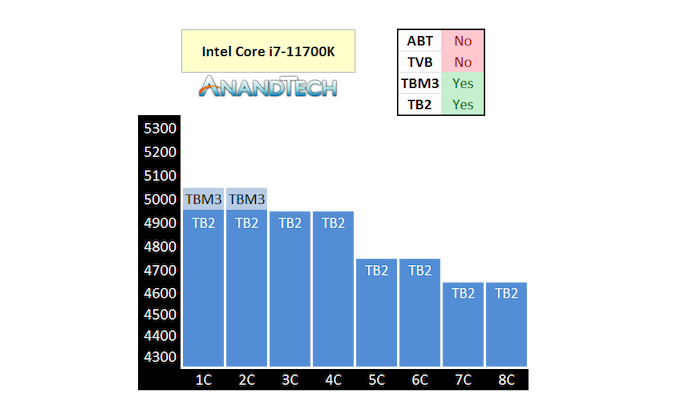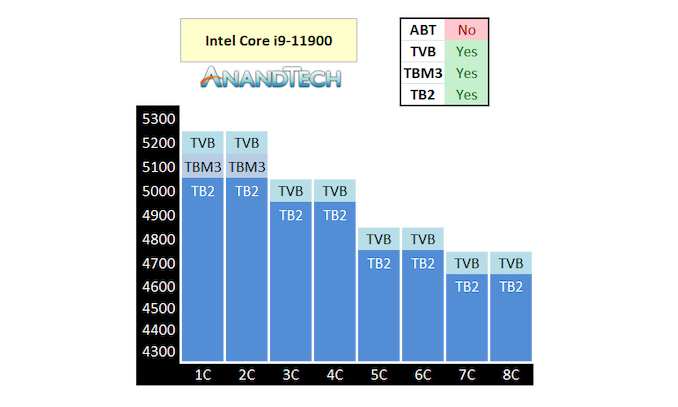Intel Rocket Lake (14nm) Review: Core i9-11900K, Core i7-11700K, and Core i5-11600K
by Dr. Ian Cutress on March 30, 2021 10:03 AM EST- Posted in
- CPUs
- Intel
- LGA1200
- 11th Gen
- Rocket Lake
- Z590
- B560
- Core i9-11900K
Intel’s New Adaptive Boost Technology for Core i9-K/KF
Taken from our news item
To say that Intel’s turbo levels are complicated to understand is somewhat of an understatement. Trying to teach the difference between the turbo levels to those new to measuring processor performance is an art form in of itself. But here’s our handy guide, taken from our article on the subject.
Adaptive Boost Technology is now the fifth frequency metric Intel uses on its high-end enthusiast grade processors, and another element in Intel’s ever complex ‘Turbo’ family of features. Here’s the list, in case we forget one:
| Intel Frequency Levels | ||
| Base Frequency | - | The frequency at which the processor is guaranteed to run under warranty conditions with a power consumption no higher than the TDP rating of the processor. |
| Turbo Boost 2.0 | TB2 | When in a turbo mode, this is the defined frequency the cores will run at. TB2 varies with how many cores are being used. |
| Turbo Boost Max 3.0 | TBM3 'Favored Core' |
When in a turbo mode, for the best cores on the processor (usually one or two), these will get extra frequency when they are the only cores in use. |
| Thermally Velocity Boost | TVB | When in a turbo mode, if the peak thermal temperature detected on the processor is below a given value (70ºC on desktops), then the whole processor will get a frequency boost of +100 MHz. This follows the TB2 frequency tables depending on core loading. |
| Adaptive Boost Technology | ABT 'floating turbo' |
When in a turbo mode, if 3 or more cores are active, the processor will attempt to provide the best frequency within the power budget, regardless of the TB2 frequency table. The limit of this frequency is given by TB2 in 2-core mode. ABT overrides TVB when 3 or more cores are active. |
| *Turbo mode is limited by the turbo power level (PL2) and timing (Tau) of the system. Intel offers recommended guidelines for this, but those guidelines can be overridden (and are routinely ignored) by motherboard manufacturers. Most gaming motherboards will implement an effective ‘infinite’ turbo mode. In this mode, the peak power observed will be the PL2 value. It is worth noting that the 70ºC requirement for TVB is also often ignored, and TVB will be applied whatever the temperature. | ||
Intel provided a slide trying to describe the new ABT, however the diagram is a bit of a mess and doesn’t explain it that well. Here’s the handy AnandTech version.
First up is the Core i7-11700K that AnandTech has already reviewed. This processor has TB2, TBM3, but not TVB or ABT.
The official specifications show that when one to four cores are loaded, when in turbo mode, it will boost to 4.9 GHz. If it is under two cores, the OS will shift the threads onto the favored cores and Turbo Boost Max 3.0 will kick in for 5.0 GHz. More than four core loading will be distributed as above.
On the Core i9-11900, the non-overclocking version, we also get Thermal Velocity Boost which adds another +100 MHz onto every core max turbo, but only if the processor is below 70ºC.
We can see here that the first two cores get both TBM3 (favored core) as well as TVB, which makes those two cores give a bigger jump. In this case, if all eight cores are loaded, the turbo is 4.6 GHz, unless the CPU is under 70ºC, then we get an all-core turbo of 4.7 GHz.
Now move up to the Core i9-11900K or Core i9-11900KF, which are the only two processors with the new floating turbo / Adaptive Boost Technology. Everything beyond two cores changes and TVB no longer applies.
Here we see what looks like a 5.1 GHz all-core turbo, from three cores to eight cores loaded. This is +300 MHz above TVB when all eight cores are loaded. But the reason why I’m calling this a floating turbo is because it is opportunistic.
What this means is that, if all 8 cores are loaded, TB2 means that it will run at 4.7 GHz. If there is power budget and thermal budget, it will attempt 4.8 GHz. If there is more power budget and thermal budget available, it will go to 4.9 GHz, then 5.0 GHz, then 5.1 GHz. The frequency will float as long as it has enough of those budgets to play with, and it will increase/decrease as necessary. This is important as different instructions cause different amounts of power draw and such.
If this sounds familiar, you are not wrong. AMD does the same thing, and they call it Precision Boost 2, and it was introduced in April 2018 with Zen+. AMD applies its floating turbo to all of its processors – Intel is currently limiting floating turbo to only the Core i9-K and Core i9-KF in Core 11th Gen Rocket Lake.
One of the things that we noticed with AMD however is that this floating turbo does increase power draw, especially with AVX/AVX2 workloads. Intel is likely going to see similar increases in power draw. What might be a small saving grace here is that Intel’s frequency jumps are still limited to full 100 MHz steps, whereas AMD can do it on the 25 MHz boundary. This means that Intel has to manage larger steps, and will likely only cross that boundary if it knows it can be maintained for a fixed amount of time. It will be interesting to see if Intel gives the user the ability to change those entry/exit points for Adaptive Boost Technology.
There will be some users who are already familiar with Multi-Core Enhancement / Multi-Core Turbo. This is a feature from some motherboard vendors have, and often enable at default, which lets a processor reach an all-core turbo equal to the single core turbo. That is somewhat similar to ABT, but that was more of a fixed frequency, whereas ABT is a floating turbo design. That being said, some motherboard vendors might still have Multi-Core Enhancement as part of their design anyway, bypassing ABT.
Overall, it’s a performance plus. It makes sense for the users that can also manage the thermals. AMD caught a wind with the feature when it moved to TSMC’s 7nm. I have a feeling that Intel will have to shift to a new manufacturing node to get the best out of ABT, and then we might see the feature on the more mainstream CPUs, as well as becoming default as standard.













279 Comments
View All Comments
mitox0815 - Tuesday, April 13, 2021 - link
The development doesn't seem so special when you think about how extremely high-tech this market is...freshly entering it without special circumstances is nearly impossible. The entry barriers are crazy. So increasing market consolidation seems natural.TrueJessNarmo - Tuesday, March 30, 2021 - link
5600x abnormally topping the gaming charts.On gamers nexus charts on the other hand it was consistently below 5800x/5900x/5950x in gaming even though they clearly have strong bias towards 6 core budget CPU's in their recommendation.
Completely opposite picture. Why is that?
Hifihedgehog - Tuesday, March 30, 2021 - link
It may come down to the memory settings. Ian strictly follows JEDEC timings which all reviewers should.TrueJessNarmo - Tuesday, March 30, 2021 - link
Stock 5600x has lower clocks vs 5800x/5900x/5950x. It should be slower. Any other result is abnormal.Besides Gamers nexus is arguably the most trusted and the most accurate benchmarks in regards to gaming, CPU's and GPU's. You can read up on their test methodology here:
https://www.gamersnexus.net/guides/3577-cpu-test-m...
I suspect it has something to do with subtle insufficient power or cooling or both. Or perhaps they just have really great 5600x sample and really terrible 5800x/5900x samples.
BushLin - Tuesday, March 30, 2021 - link
They absolutely shouldn't if their audience is mostly buying decent ram and enabling XMP. I would argue that people reading anandtech deserve to see what a platform can reasonably deliver rather than castrated pre-built systems. DDR4-3600 isn't expensive or unstable for modern platforms.Hifihedgehog - Tuesday, March 30, 2021 - link
I realize this, but AnandTech is in the interesting position of appealing to both enthusiasts and professionals so using JEDEC is an effort to give a nod to the professional side of the audience... presumably, at least. Nonetheless, I agree: I have always used XMP/DOHC settings since day 1 of Ryzen as much as possible so it would be nice to see the performance with faster RAM settingsOxford Guy - Wednesday, March 31, 2021 - link
' Ian strictly follows JEDEC timings which all reviewers should.'BS. Motherboard makers even put out lists of supported XML RAM sticks.
They try to have their cake and eat it, to justify their kneecapping of Zen 1 and 2.
• Extremely high CFM coolers, with no decibel level information
• Allowing boards to bypass the supposed Intel standard for turbo
No, sorry... they're trying to make Intel look and sound good because they want to retain early access. It's part of the devil's bargain the tech press has to follow. Either pay the piper by posting a lot of awful spin and tricky tactics or be excluded and lose all those clicks to others.
Qasar - Wednesday, March 31, 2021 - link
here is a thought, if you think AT is doing such a crappy job with their testing methodology, go make your OWN review site, and review products how think it should be done, problem solvedOxford Guy - Thursday, April 1, 2021 - link
It’s not a particularly original nor useful thought. Feedback from customers is valued by most businesses.Qasar - Thursday, April 1, 2021 - link
not when they sound more like whinning and complaining